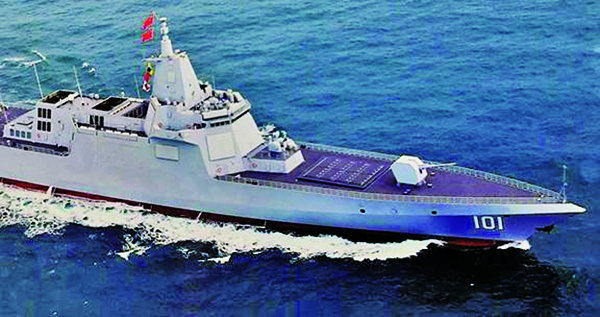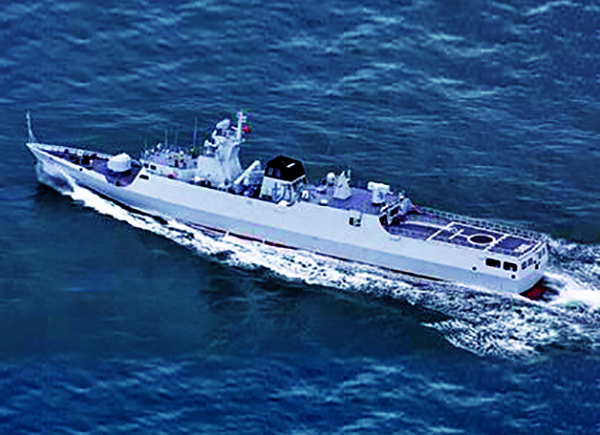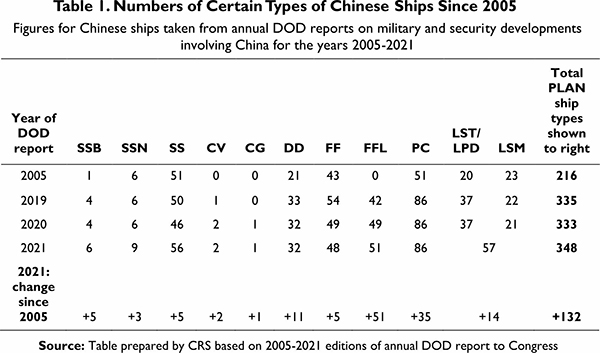Surface Combatants
Overview
China since the early 1990s has put into service numerous new classes of indigenously built surface combatants, including a new cruiser (or large destroyer), several classes of destroyers and frigates, a new class of corvettes (i.e., light frigates), and a new class of missile-armed patrol craft.
These new classes of surface combatants demonstrate a significant modernization of PLA Navy surface combatant technology. DOD states that China’s navy “remains engaged in a robust shipbuilding program for surface combatants, producing new guided-missile cruisers (CGs), guided-missile destroyers (DDGs) and corvettes (FFLs). These assets will significantly upgrade the PLAN’s air defense, anti-ship, and anti-submarine capabilities and will be critical as the PLAN expands its operations beyond the range of the PLA’s shore-based air defense systems.” DIA states that “the era of past designs has given way to production of modern multi-mission destroyer, frigate, and corvette classes as China’s technological advancement in naval design has begun to approach a level commensurate with, and in some cases exceeding, that of other modern navies.” China is also upgrading its older surface combatants with new weapons and other equipment.
Type 055 Cruiser/Large Destroyer
China is building a new class of cruiser (or large destroyer), called the Renhai-class or Type 055, that reportedly displaces between 12,000 and 13,000 tons. A March 7, 2021, press report by a Chinese media outlet states that the ship displaces more than 12,000 tons. By way of comparison, the U.S. Navy’s Ticonderoga (CG-47) class cruisers and Arleigh Burke (DDG-51) class destroyers (aka the U.S. Navy’s Aegis cruisers and destroyers) displace about 10,100 tons and 9,700 tons, respectively, while the U.S. Navy’s three Zumwalt (DDG-1000) class destroyers displace about 15,700 tons.
ONI states that Type 055 ships are being built by two shipyards. The first was reportedly commissioned into service in January 2020. A total of six were reportedly in service as of August 2022. In August 2020, it was reported that the seventh was delivered to the navy in May 2020, and that the eighth was launched on August 30, 2020, and “will complete the first group of Type 055 destroyers.” A January 2022 press report states that in addition to the first eight ships, at least two more are under construction.
Type 052 Destroyer
China since the early 1990s has put into service multiple new classes of indigenously built destroyers, the most recent of which is the Luyang III (Type 052D) class, which displaces about 7,500 tons and is equipped with phased-array radars and vertical launch missile systems that outwardly are broadly similar to those on U.S. Navy cruisers and destroyers. Type 052D ships have been in serial production for some time; an August 21, 2022, press report states that 25 of the ships are in service and at least six more are under construction at the two shipyards that build Type 052 destroyers. Press reports in March 2021 stated that China is now commissioning an upgraded version of the Type 052D, informally called the Type 052DL, that incorporates an extended-length helicopter flight deck and a new radar.
Type 054 Frigate
China since the early 1990s has also put into service multiple new classes of indigenously built frigates, the most recent of which is the Jiangkai II (Type 054A) class, which displaces about 4,000 tons. ONI stated in February 2020 that 30 Type 054As entered service between 2008 and 2019, and that no additional Type 054As were then under construction. An August 2021 press report from a Chinese media outlet, however, stated that “China is reportedly building another batch of Type 054A frigates for the People’s Liberation Army Navy (PLA Navy) after it had launched two new ships of this class over the past few months.” The press report noted that a report from the Jane’s organization had stated that the 32nd Type 054A ship had recently been launched (i.e., put into the water for the final stages of its construction). A May 7, 2022, press report stated:
“Speculation is mounting among China’s military observers that construction is about to start on a bigger and faster frigate, designed to keep up with the PLA Navy’s third aircraft carrier which is nearing completion.”
An open tender for super high-strength structural steel – the kind used in military hulls – was issued by the Huangpu Wenchong shipyard in Guangzhou, southern China, in March, with a delivery date of May 20.
It is unclear how many tonnes of the CCS-B structural steel plate were ordered by the shipyard, a subsidiary of the China State Shipbuilding Corporation (CSSC).
Several military commentators have taken to Chinese social media platforms to suggest the order could signal that work is about to begin on a bigger, faster multi-role update of the Type 054A, better suited to combat operations on the high seas.
Type 056 Corvette
China has also built-in large numbers over a relatively short time period-a new type of corvette (i.e., a light frigate, or FFL) called the Jiangdao class or Type 056, which reportedly displaces 1,300 tons to 1,500 tons. Type 056 ships were built at a high annual rate in four shipyards-the first was commissioned in 2013, and the 72nd and final ship of the type was reportedly commissioned in early 2021, implying an average commissioning rate of about eight ships per year. DOD states that China’s navy “commissioned its ninth Jiangdao over the year by mid-2020 with over 50 Jiangdao class FFLs in service out of an expected production run of at least 70 ships. The latest FFLs are anti-submarine warfare (ASW) variants with a towed-array sonar.”
ONI states that as of February 2020, more than 50 had entered service and another 15 were under construction. In February 2021, a Chinese media outlet reported that the final two Type 056 ships-the 71st and 72nd such ships-had been commissioned into service in January and February 2021, and that the completion of Type 056 production could permit a shift to production of greater numbers of larger warships.
Beginning in November 2021, it was reported that 20 to 22 of the ships were being transferred to China’s coast guard and modified for coast guard operations, which would leave 50 to 52 in China’s navy. Table 1 shows a total of 51 Type 056 ships in China’s navy as of 2021. As shown in Table 1, the rapid growth in the number of Type 056 corvettes since 2013 accounts for a substantial share of the net increase in the total number of ships in China’s navy since 2013.
Amphibious Ships
Type 071 Amphibious Ship
China’s new Yuzhao or Type 071 amphibious ships have an estimated displacement of more than 19,855 tons, compared to about 25,900 tons for the U.S. Navy’s new San Antonio (LPD-17) class amphibious ships. A May 6, 2021, press report states that the eighth Type 0721 ship “recently made its first publicly known maritime exercise appearance.”
Type 075 Amphibious Assault Ship
In April 2021, China commissioned into service the first of a new type of amphibious assault ship, called the Yushen or Type 075 that has an estimated displacement of about 35,000 tons, compared to 41,000 to 45,000 tons for U.S. Navy LHA/LHD-type amphibious assault ships. In March 2022, it was reported that the first Type 075 ship had achieved initial operational capability (IOC), although that term might not mean the same as it does when used by DOD in connection with U.S. weapon systems.
The second Type 075 ship reportedly was commissioned into service in late December 2021. The third was reportedly commissioned on or perhaps a few days prior to October 1, 2022.
In July 2020, it was reported that China might be planning to build the first of a new class of amphibious assault ships, called the Type 076 by observers that would be equipped with electromagnetic catapults, which would enhance its ability to support operations by fixed-wing aircraft and make it somewhat more like an aircraft carrier.
Amphibious Ship Roles and Missions
Although larger amphibious ships such as the Type 071 and Type 075 would be of value for conducting amphibious landings in Taiwan-related conflict scenarios, some observers believe that China is building such ships as much for their value in conducting other operations, such as operations for asserting and defending China’s claims in the South and East China Seas, humanitarian assistance/disaster relief (HA/DR) operations, maritime security operations (such as anti-piracy operations), and noncombatant evacuation operations (NEOs). Politically, amphibious ships can also be used for naval diplomacy (i.e., port calls and engagement activities) and for impressing or intimidating foreign observers.
Potential Use of Commercial Ships
In assessing China’s capacity for conducting an amphibious invasion of Taiwan, some observers have focused on China’s potential for using civilian ferries and other commercial ships to augment the transport and landing capacity of China’s amphibious ships. Reported Chinese exercises indicate that China is exploring and testing this concept.
Operations Away from Home Waters
Ship Operations
Although China’s navy operates primarily in China’s home waters, Chinese navy ships are conducting increasing numbers of operations away from China’s home waters, including the broader waters of the Western Pacific, the Indian Ocean, and the waters surrounding Europe, including the Mediterranean Sea and the Baltic Sea. A November 23, 2019, DOD news report quoted Admiral Philip Davidson, the commander of the U.S. Indo-Pacific Command, as stating that China’s navy had conducted more global naval deployments in the past 30 months than it had in the previous 30 years.
While many of China’s long-distance naval deployments have been for making diplomatic port calls, some of them have been for other purposes, including conducting training exercises and carrying out anti-piracy operations in waters off Somalia. China has been conducting anti-piracy operations in waters off Somalia since December 2008 via a succession of more than 40 rotationally deployed naval escort task forces.
Current or Potential Bases Outside China
China’s distant naval operations are supported in part by China’s military base in Djibouti, which China officially opened in August 2017 as its first overseas military base.
In December 2021, it was reported that China may be seeking to establish a military (including naval) base at a port in Equatorial Guinea, a country located on the Atlantic coast of Africa-a location that could enhance China’s ability to conduct naval operations in the Atlantic.
A June 8, 2022, press report stated: “Cambodian and Chinese officials broke ground on a Beijing-funded expansion of Ream Naval Base on [June 8], using the occasion to again reject reports the site will be used by China’s military.” A June 6, 2022, press report stated:
“China is secretly building a naval facility in Cambodia for the exclusive use of its military, with both countries denying that is the case and taking extraordinary measures to conceal the operation, Western officials said. The military presence will be on the northern portion of Cambodia’s Ream Naval Base on the Gulf of Thailand….
“The Wall Street Journal reported in 2019 that China had signed a secret agreement to allow its military to use the base, citing U.S. and allied officials familiar with the matter….
“Over the weekend… a Chinese official in Beijing confirmed to The Washington Post that “a portion of the base” will be used by “the Chinese military….
“The two governments have taken pains to mask the presence of the Chinese military at Ream, the official said….
“The secrecy around the base appears to be driven primarily by Cambodian sensitivities and concern about a domestic backlash, the second official said.”
A security agreement between China and the Solomon Islands that was announced by the Solomon Islands in April 2020 has led some observers to express concern that the agreement could eventually lead to, among other things, the establishment of a Chinese naval base in that country. The Prime Minister of the Solomon Islands ruled out that possibility, stating that it would “put our country and our people as targets for potential military strikes.”
Based on the US Congressional Reserach Service Report on China Naval Modernisation, Nov 2022




















